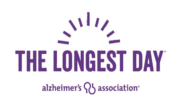Findings from two national surveys appearing in the Alzheimer’s Association 2021 Alzheimer’s Disease Facts and Figures report reveal that discrimination is a barrier to Alzheimer’s and dementia care. More than one-third of Black Americans (36%) and nearly one-fifth of Hispanic Americans (18%) and Asian Americans (19%), believes discrimination would be a barrier to receiving Alzheimer’s care. In addition, half or more of non-White caregivers say they have experienced discrimination when navigating health care settings for their care recipient.
- The 2021 Facts and Figures report provides an in-depth look at the latest national statistics on Alzheimer’s prevalence, incidence, mortality, costs of care and impact on caregivers. New disease-related statistics for North Carolina revealed the following:
- Number of North Carolina residents aged 65 and older living with Alzheimer’s: 180,000
- Estimated number of North Carolina residents living with Alzheimer’s in 2025: 210,000
- Percentage change: 16.7 % increase
- Statewide deaths from Alzheimer’s disease (2019): 4,508
- Number of North Carolina residents serving as unpaid family caregivers: 358,000
- Total hours of unpaid care provided: 517 million
- Total value of unpaid care: $7.3 billion
“The new Facts and Figures report shows that Alzheimer’s disease and other dementias continue to be a significant burden for too many North Carolina families,” said Katherine L. Lambert, CEO of the Alzheimer’s Association, Western Carolina Chapter. “We must continue to work toward advancing new treatments that can stop or slow the progression of Alzheimer’s, while also continuing to provide care and support services to help all those affected.”
For the first time, the accompanying special report, “Race, Ethnicity and Alzheimer’s in America,” examines perspectives and experiences of Asian, Black, Hispanic, Native and White Americans in regard to Alzheimer’s and dementia care.
- Findings in the report, reveal that non-White racial/ethnic populations expect and experience more barriers when accessing dementia care, have less trust in medical research and are less confident that they have access to health professionals who understand their ethnic and racial background and experiences. Among the findings:
- Two-thirds of Black Americans (66%) believe it is harder for them to get excellent care for Alzheimer’s disease or other dementias. Likewise, 2 in 5 Native Americans (40%) and Hispanic Americans (39%) believe their own race or ethnicity makes it harder to get care, as do one-third of Asian Americans (34%).
- Nearly two-thirds of Black Americans (62%) believe that medical research is biased against people of color — a view shared by substantial numbers of Asian Americans (45%), Native Americans (40%) and Hispanic Americans (36%) as well. Only half of Black Americans (53%) trust a future cure for Alzheimer’s will be shared equally regardless of race, color or ethnicity.
- Fewer than half of Black (48%) and Native Americans (47%) feel confident they have access to providers who understand their ethnic or racial background and experiences, and only about 3 in 5 Asian Americans (63%) and Hispanics (59%) likewise feel confident.
“Despite ongoing efforts to address health and health care disparities in Alzheimer’s and dementia care, survey results show there is still a lot of work to be done,” said Carl V. Hill, Ph.D., MPH. chief diversity, equity and inclusion officer, Alzheimer’s Association. “Clearly, discrimination, lack of diversity among health care professionals and mistrust in medical research create significant barriers to care and demand the country’s full attention.”
Episodes of discrimination, however, extend beyond Alzheimer’s and dementia care, the Alzheimer’s Association surveys found that many non-White Americans say they have experienced discrimination in the broader health care system. Specifically, half of Black Americans (50%) report they’ve experienced discrimination when seeking health care; more than 4 in 10 Native Americans (42%) and one-third of Asian Americans (34%) and Hispanic Americans (33%) likewise report having experienced health care discrimination.
The experiences and views of discrimination expressed by respondents in both surveys are also reflected in their views on clinical trial participation.
Black Americans have less interest in clinical research trials to prevent or slow the progression of Alzheimer’s disease. White Americans are most likely to express interest (82%), followed by Native Americans (81%), Hispanic Americans (78%), Asian Americans (73%) and lastly, Black Americans (67%).
The most common reason cited for not participating in clinical trials among all racial/ethnic groups is not wanting to be a “guinea pig.” This sentiment was especially strong among Black Americans (69%). In addition almost half of Black Americans (45%) worry that treatments might cause sickness. They are also twice as likely as other groups to say they “don’t trust medical research.” And they are more than twice as likely as other racial or ethnic groups to say they “might not be treated fairly.”
As noted in the 2021 Facts and Figures report, health and socioeconomic disparities and systemic racism contribute to increased Alzheimer’s and dementia risk in communities of color. According to the report, older Blacks and Hispanics are also disproportionately more likely to have Alzheimer’s and other dementias. In addition, both groups are more likely to have missed diagnoses than older whites.
Impact of COVID-19
The report also examines the devastating impact the COVID-19 pandemic is having on people living with Alzheimer’s. According to the report, there were at least 42,000 more deaths from Alzheimer’s and other dementias in 2020 compared with averages over the previous five years – a 16% increase.
In North Carolina there were 1,082 more deaths from Alzheimer’s and dementia in 2020 than compare to averages over the past five years – an 11.3% increase.
The report highlights preliminary and anecdotal data indicating the COVID-19 pandemic is also having adverse effects on many family caregivers. It notes that pandemic-related caregiving challenges, including the shutdown of adult day care centers and the inability of families to visit or communicate with relatives in long-term care settings have caused “emotional distress and other negative outcomes among caregivers.”
“While more study is needed to understand the exact reasons why deaths attributable to Alzheimer’s and dementia during the pandemic have increased so dramatically, we do know individuals living with Alzheimer’s, particularly those living in long-term care settings are extremely vulnerable,” said Lambert. “In addition, many caregivers have been unable to visit loved ones in these settings, resulting in social isolation for the care recipient and causing enormous stress for these families. The Alzheimer’s Association is committed to supporting North Carolina caregivers and implementing the safety measures needed to reunite these families.”
2021 Alzheimer’s Disease Facts and Figures: At a Glance
Prevalence, Incidence and Mortality
- An estimated 6.2 million Americans age 65 and older are living with Alzheimer’s dementia in 2021.
- More than 1 in 9 people (11.3%) age 65 and older has Alzheimer’s dementia.
- Two-thirds of Americans over age 65 with Alzheimer’s dementia (3.8 million) are women.
- Deaths due to Alzheimer’s between 2000 and 2019, has more than doubled, increasing 145%.
- 1 in 3 seniors dies with Alzheimer’s or another dementia.
Caregiving
- In 2020, more than 11 million caregivers of people with Alzheimer’s or other dementias provided an estimated 15.3 billion hours of unpaid care, a contribution to the nation valued at $257 billion.
- Nearly half of all caregivers (48%) who provide help to older adults do so for someone with Alzheimer’s or another dementia.
- Approximately two-thirds of caregivers are women, and one-third of dementia caregivers are daughters.
- Forty-one percent of caregivers have a household income of $50,000 or less.
Cost of Care
- In 2021, total payments for all individuals with Alzheimer’s or other dementias are estimated at $355 billion (not including unpaid caregiving).
- Medicare and Medicaid are expected to cover $239 billion or 67% of the total health care and long-term care payments for people with Alzheimer’s or other dementias. Out-of-pocket spending is expected to be $76 billion.
- Total payments for health care, long-term care and hospice care for people with Alzheimer’s and other dementias are projected to increase to more than $1.1 trillion in 2050.
- The total lifetime cost of care for someone with dementia is estimated at $373,527.
Additional data from the report is included below. Full text of the 2021 Alzheimer’s Disease Facts and Figures report, including the accompanying special report, “Race, Ethnicity and Alzheimer’s in America,” can be viewed at alz.org/facts. The report will also appear in the March 2021 issue of Alzheimer’s & Dementia: The Journal of the Alzheimer’s Association.
Other Key Findings from “Race, Ethnicity and Alzheimer’s in America:”
- Concern about developing Alzheimer’s is lower among Native Americans (25%), Blacks (35%) and Hispanics (41%), especially when compared with Whites (48%).
- More than one-third of Native Americans (35%) and nearly 3 in 10 Hispanics (28%) do not believe they will live long enough to develop Alzheimer’s or another dementia.
- More than half of non-White Americans believe significant loss of memory or cognitive abilities is “a normal part of aging.”
- Hispanic, Black and Native Americans are twice as likely as Whites to say they would not see a doctor if experiencing thinking or memory problems.
- One in 5 Black (21%) and Hispanic Americans (20%) say they would feel insulted if a doctor suggested a cognitive assessment.
- Nearly 2 in 3 caregivers (64%) across all groups say that caregiving is stressful, but nearly all (92%) say caregiving is rewarding as well.
Updated Alzheimer’s Statistics
The Alzheimer’s Association Facts and Figures report also provides an annual look at the latest national statistics and information on Alzheimer’s prevalence, incidence, mortality and morbidity, costs of care and caregiving, both nationally and state-by-state.
About 2021 Alzheimer’s Disease Facts and Figures
TheAlzheimer’s Association 2021 Alzheimer’s Disease Facts and Figures report is a comprehensive compilation of national statistics and information on Alzheimer’s disease and related dementias. The report conveys the impact of Alzheimer’s on individuals, families, government and the nation’s health care system. Since its 2007 inaugural release, the report has become the preeminent source covering the broad spectrum of Alzheimer’s issues. The Facts and Figures report is an official publication of the Alzheimer’s Association.
About the Survey
Versta Research conducted two surveys on behalf of the Alzheimer’s Association: (1) U.S. adults and (2) current or recent caregivers of adults age 50 or older with cognitive issues. Respondents were asked about access to care and support services, trust in providers and the health care system, participation in clinical trials and research, and caregiver experiences. Surveys were conducted October 26 – November 11, 2020. Data was collected by NORC at the University of Chicago via the AmeriSpeak® panel. AmeriSpeak is a probability-based panel of all U.S. households.
The survey included 945 White respondents. Oversamples of Hispanic (n=541), Black (n=515) and Asian Americans (n=412) were weighted back to their true population proportions for statistical analysis and reporting. For full inclusion of Native Americans, the same survey was administered to an additional sample of 406 Native Americans recruited through online (non-probability) panels with sampling stratified and data weighted on gender, age, income and education to match U.S. Census Bureau data. The surveys were offered in both English and Spanish. For complete details regarding survey methodology, see page 73 of the report.












